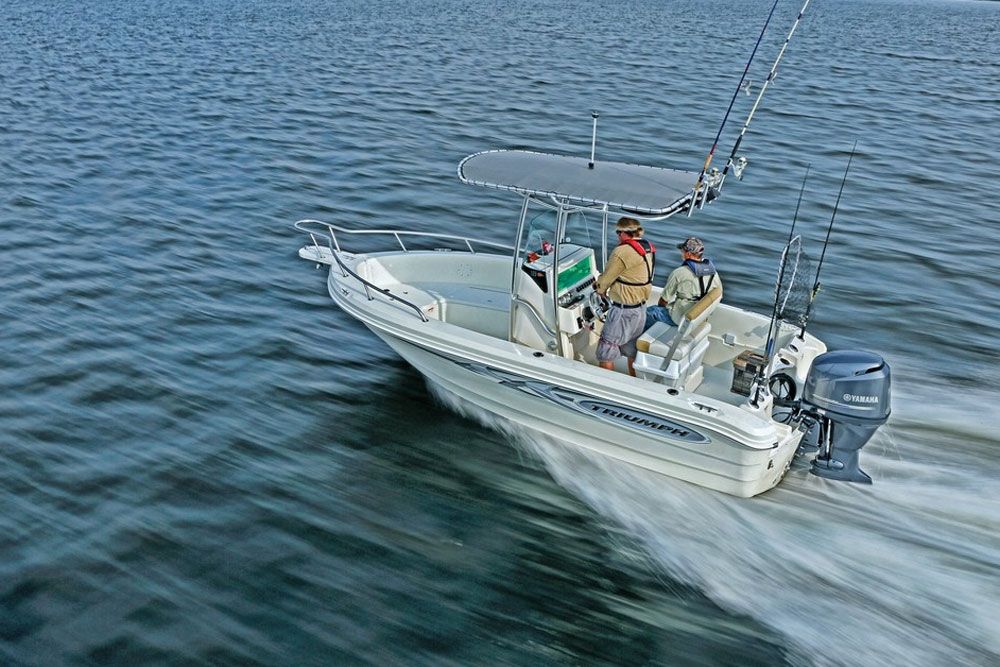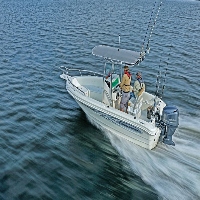Plastic may seem like a strange boat-building material, but then when you read an article like Basic Boat Construction: Resin, Fiberglass, and Cores you’ll be reminded of the fact that what we call fiberglass is, in fact, a form of plastic. So why should it surprise so many boaters that a different form of plastic, called polyethylene, also turns out to be an excellent boat-building material? Truth be told, it shouldn’t.
Triumph builds some of the largest and best-looking plastic boats around, using a type of polyethylene combined with UV protecting materials, pigments, and antioxidants, which they call “Roplene.”

In a nutshell, here are the major advantages and disadvantages of polyethylene as opposed to fiberglass or aluminum:
- ADVANTAGE: Polyethylene is extremely impact-resistant, and we’ll go as far as to say that poly boats are virtually indestructible in the normal course of recreational boating. Smash into a rock jetty, much less a piling, and a poly boat will just bounce right off. Whack the hullsides with a sledgehammer (Triumph will invite you to at the boat shows) and there’s zero effect. One of our editors owned a 10’ poly boat which fell out the back of a pick-up truck while doing 50 MPH, and after bouncing down the road and off onto the shoulder, other than a few scuff marks it remained undamaged.
- DISADVANTAGE: Polyethylene isn’t as structurally stiff as fiberglass or aluminum, so poly boats are limited in size. There are few over 20’ and many of the relatively large models require structural hull supports built from different materials.
- ADVANTAGE: Poly boats are molded, so like fiberglass boats, they can have hulls with complex shapes and compound curves; decks can have molded-in compartments; and large accessories like seat bases or consoles can also be molded. Aluminum boats aren’t molded, so they tend to have much simpler hullforms and accessories must be secured in place with fasteners.
- DISADVANTAGE: Molding tolerances are not as exact as they are with fiberglass, so items like hatches may not fit as perfectly as they would on a fiberglass boat. Many aluminum boats also have more exact tolerances, even though the parts are fabricated as opposed to molded.
- ADVANTAGE: Waxing and polishing are maintenance chores of the past, when you own a plastic boat. A scrub brush and soapy water is all you’ll ever need to get the boat looking as ship-shape as possible.
- DISADVANTAGE: Poly boats don’t look quite as nice as fiberglass boats, because they don‘t have a glossy gel coat. Some modern painted aluminum finishes also out-shine plastic. And while some poly boats do have an appealing finish (Triumph again comes to mind) many others have dull coloration and very limited visual appeal.
- ADVANTAGE: Polyethylene boats are often considered more environmentally-friendly than fiberglass, since they can be recycled.
Polyethylene Boat Construction
So, just how is a plastic boat built in the first place? The specifics vary from one builder to the next, but the process is generally similar. The boat begins as plastic beads or powders, which are loaded into a closed mold. The mold is then heated to melt the plastic, and is rotated to evenly distribute the material. After the mold cools, it’s opened and the hull and/or deck can be popped out.

In the case of very small, simple boats like dinghies or kayaks, the molding process may account for virtually all of the construction process. But with larger or more complex models, after the major parts of the boat have been molded a good amount of additional work may be necessary and construction is more or less like that of a fiberglass boat. Structural components are added as necessary, hulls and decks may need to be joined, and voids may be filled with foam.
Construction quality for these later stages can vary quite a bit from manufacturer to manufacturer, so before buying a plastic boat you need to do some homework and make sure it’s up to the job you plan on tasking it with. We’ve seen, for example, one small two-part poly boat (remember that 10-footer that bounced down the road?) where the hull and deck were merely stapled together, then covered with a rubrail. Sure, the staples were heavy-duty, but they weren’t exactly stainless-steel—after four years of saltwater use they corroded and the hull and deck began to separate.
Polyethylene boat construction also leads to some very odd properties. Stickers don’t stick to their slick surfaces, for example, which can make putting on registration decals and numbers a challenge. (Tip: Stencils and a black Sharpie permanent marker actually work quite well). Adding accessories like cup holders or fishing rod holders can also be a challenge since screws rip through polyethylene more easily than fiberglass or wood, and adding backing plates is often necessary. And in some cases bottom painting requires special treatment, such as “flashing” (heating but not melting) the bottom with a torch prior to application.
Decisions, Decisions
Is a plastic boat the best choice for your needs? You’ll have to take all of the things we’ve discussed here into consideration before making up your mind, but if you’re looking for a dinghy, kayak, or very small fishing boat (under 12’) to a great degree the marketplace has already answered this question for you. Poly boats have more or less cornered this market, and you’ll have a difficult time finding fiberglass boats of this size and type. Other than car-topper-style jon boats, you won’t see many aluminum boats of this genre, either.
As far as larger sizes and more complex styles of boats go, your range of poly choices will shrink as the fiberglass and aluminum options quickly expand. Still, if you’re looking for something between 12’ and 20’ there are strong arguments to be made for buying a polyethylene boat.







